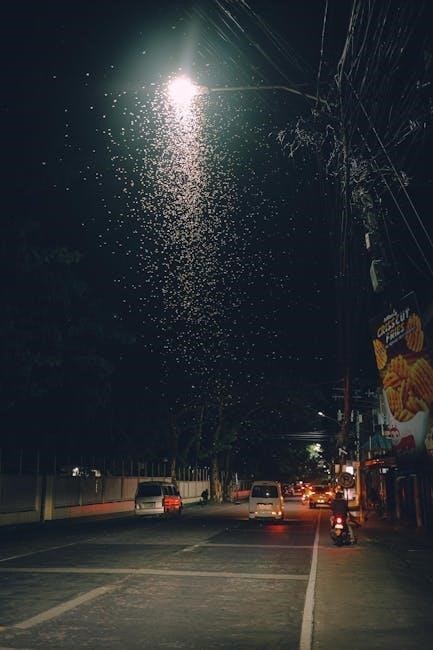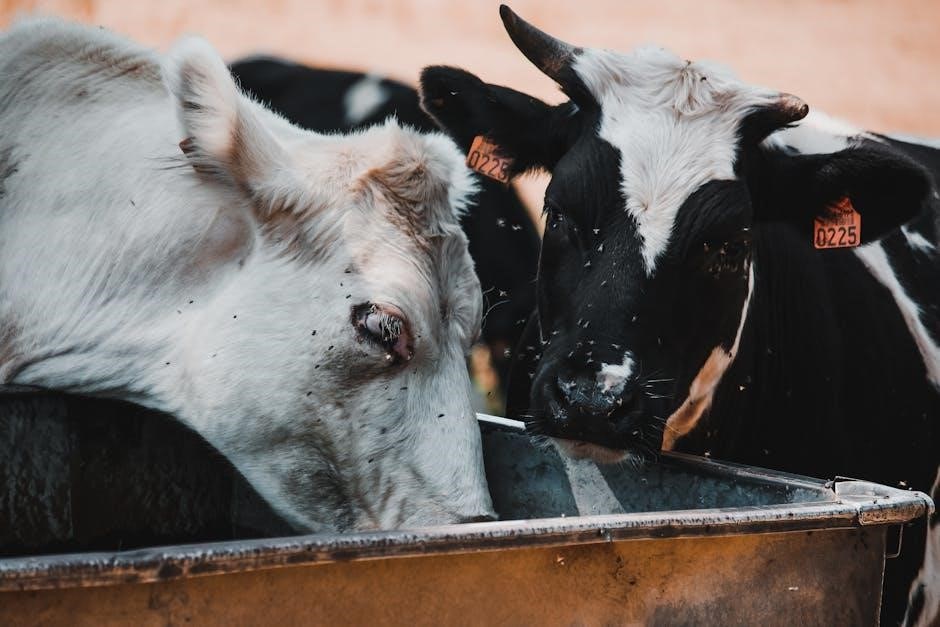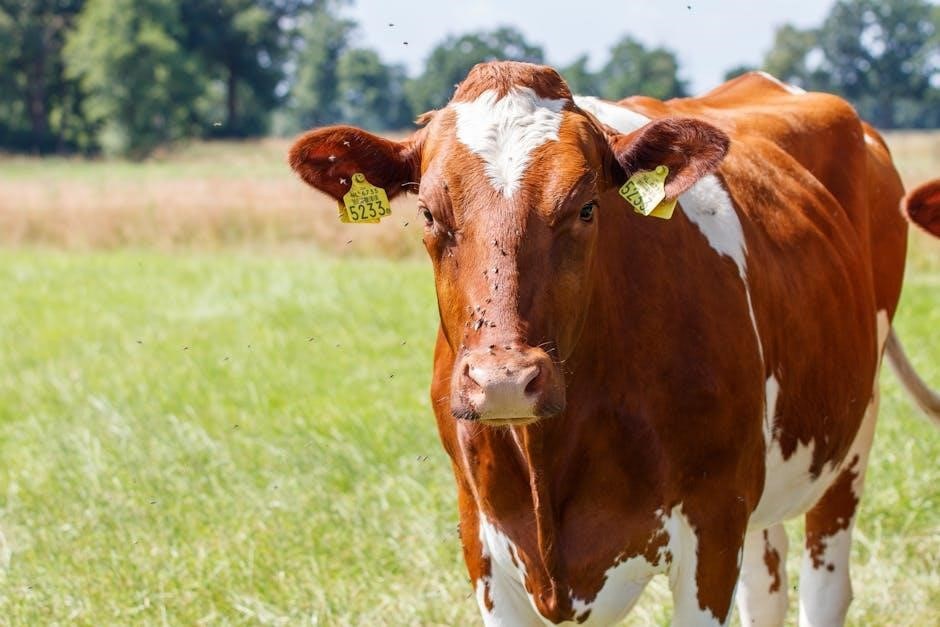Lord of the Flies, a thought-provoking novel by William Golding, explores human nature, civilization, and savagery. Available as a free PDF download, it offers a gripping tale of boys stranded on an island, revealing societal truths through their experiences. This e-book format allows easy access to the classic story, making it a popular choice for readers worldwide.
Overview of the Novel
Lord of the Flies, written by William Golding, is a captivating tale of survival and human nature. Published in 1954, the novel follows British schoolboys stranded on a remote island after a plane crash. With no adult supervision, the boys attempt to create a utopian society but gradually descend into chaos and savagery. The story explores themes of civilization, morality, and the inherent darkness within humanity. Available as a free PDF download, this classic novel remains a staple in literature, offering profound insights into societal structures and human behavior, making it a must-read for both casual readers and academic study.
Author Background: William Golding
William Golding, born in 1911 in Cornwall, England, was a renowned British novelist, playwright, and poet. Before becoming a writer, he worked as a teacher and later served in the Royal Navy during World War II. His experiences during the war profoundly influenced his writing, shaping his exploration of human nature and societal structures. Golding’s most famous work, Lord of the Flies, was published in 1954 and earned him the Nobel Prize in Literature in 1983. His writing often delves into themes of morality, savagery, and civilization, leaving a lasting impact on modern literature. His works remain widely studied and admired today.
Plot Summary
Lord of the Flies, a novel by William Golding, tells the story of boys stranded on an island who attempt to create a utopian society but descend into chaos and savagery, leading to tragic consequences.
Chapter 1: The Sound of the Shell
In the first chapter of Lord of the Flies, William Golding introduces the main characters and the island setting. Ralph, Jack, Piggy, and Simon emerge as key figures as they gather around the conch shell, a symbol of order and democracy. The boys’ initial behaviors reflect their civilized upbringing, but subtle cracks in their unity appear. Ralph’s leadership is established, while Jack’s desire for power surfaces. The conch shell’s significance is highlighted as a tool for communication and decision-making. The chapter sets the stage for the boys’ descent into chaos, offering a glimpse into their fragile societal structure.
Chapter 2: Fire on the Mountain
In Chapter 2: Fire on the Mountain, the boys’ excitement and hope for rescue are ignited with the discovery of fire. Ralph and Jack argue over the fire’s location, revealing growing tensions between them. The fire symbolizes both their desire for civilization and their primal instincts. Meanwhile, the fear of the “beast” begins to spread among the younger boys, creating unrest. This chapter highlights the struggle between order and chaos, as the boys’ behavior becomes more erratic. The fire’s significance is underscored as a lifeline to rescue, but also as a source of conflict and distraction.
Chapter 3: Huts on the Beach
In Chapter 3: Huts on the Beach, Ralph focuses on building shelters, emphasizing the importance of creating a civilized community. The boys’ efforts, however, are disorganized and lack cooperation, mirroring their growing instability. Meanwhile, Jack’s fascination with hunting becomes more pronounced, signaling his shift toward savagery. The chapter illustrates the tension between practical needs and primal desires, as the boys struggle to maintain order. The huts symbolize their attempt at stability, but the looming threat of chaos and the “beast” looms large, foreshadowing the eventual breakdown of their makeshift society.
Chapter 4: Painted Faces and Long Hair
In Chapter 4: Painted Faces and Long Hair, the boys’ primal instincts intensify as they embrace their savage nature. Jack and his hunters paint their faces to camouflage themselves while hunting, symbolizing their descent into savagery. The group’s behavior becomes more chaotic, with less emphasis on building shelters and more focus on hunting and power struggles. Ralph’s leadership is challenged as Jack’s influence grows, highlighting the tension between civilization and primal desires. The chapter underscores the boys’ gradual loss of innocence and their surrender to fear, aggression, and the thrill of the hunt, foreshadowing the breakdown of their fragile society.

Themes in “Lord of the Flies”
Exploring human nature and society, the novel delves into civilization vs. savagery, power dynamics, fear’s impact, and moral dilemmas, all central to its profound narrative.
Human Nature and Society
The novel examines how human nature unfolds when societal constraints are removed. The boys’ descent from order to chaos reflects inherent instincts, revealing that civilization is a fragile construct. Their actions expose both the capacity for cooperation and the primal urge for dominance. Golding suggests that society’s rules are essential to maintain harmony, as without them, individuals revert to primal behaviors. This theme is central to the novel, highlighting the tension between individual desire and collective order, and how quickly societal norms can disintegrate without enforcement.
Civilization vs. Savagery
The novel vividly portrays the conflict between civilization and savagery through the boys’ behavior on the island. Initially, they attempt to create a structured society, symbolized by the conch shell and democratic meetings. However, as their isolation prolongs, primal instincts dominate, leading to chaos and violence. Ralph represents order and civility, while Jack embodies the descent into savagery, prioritizing hunting over responsibility. Golding illustrates how thin the line between civilization and barbarism is, revealing that human nature, when unchecked, gravitates toward savagery. This tension drives the novel’s tragic progression, highlighting the fragility of societal norms.
The Effects of Power

The novel examines how power dynamics shape behavior, as the boys’ isolation amplifies their inherent desires for control. Ralph’s leadership, symbolized by the conch shell, initially fosters order and democracy. However, Jack’s hunger for power leads to dictatorship, as he exploits fear and violence to dominate. The novel illustrates how power corrupts, even in the absence of societal constraints. Golding shows that the pursuit of authority can erode moral boundaries, transforming individuals into rulers driven by self-interest. The conch shell, once a symbol of equality, loses its influence, reflecting the decay of democratic ideals under the weight of unchecked power. Power, in this context, reveals the darker aspects of human nature.
Fear and Its Consequences
Fear emerges as a pervasive force in Lord of the Flies, driving the boys’ actions and decisions. Initially, the fear of the unknown, embodied by the “beast,” creates tension and paranoia. As the novel progresses, fear of one another and of losing power intensifies, leading to chaos and violence. Fear disrupts their civilized behavior, pushing them toward savagery. The consequences are devastating, as fear fosters mistrust, betrayal, and ultimately, tragedy. Golding portrays fear not just as an emotion but as a catalyst for the breakdown of order, highlighting its destructive impact on human relationships and society. Fear becomes a relentless force, reshaping their world.
Morality and Ethics
Lord of the Flies delves into the complexities of morality and ethics through the boys’ actions on the island. Initially, Ralph and Piggy represent a moral framework, adhering to rules and fairness. However, as the novel progresses, the absence of adult supervision and the rise of savagery lead to a decline in ethical behavior. Jack’s desire for power and control undermines Ralph’s democratic ideals, while Simon’s tragic fate highlights the consequences of abandoning moral principles. Golding explores how inherent morality is shaped by environment and societal norms, raising questions about humanity’s capacity for both good and evil. The novel serves as a cautionary tale about the fragility of ethics in the face of primal instincts.

Characters
The novel features dynamic characters like Ralph, the democratic leader; Jack, the power-hungry hunter; Piggy, the voice of reason; and Simon, the enlightened moral guide. Each character represents distinct human traits, shaping the story’s tension and moral dilemmas.
Ralph: The Protagonist
Ralph, the protagonist, embodies leadership and civility in Lord of the Flies. Elected as the group’s leader, he symbolizes order and democracy. His desire to maintain civilization is evident through his reliance on the conch shell, a symbol of authority and fairness. Ralph’s initial optimism and sense of responsibility gradually erode as the group’s behavior becomes more savage. His inability to control the boys’ descent into chaos highlights the fragility of societal norms. Ralph’s journey from innocence to disillusionment underscores the novel’s exploration of human nature. The PDF version of the book delves into his internal struggles, revealing his growth and ultimate realization about humanity’s darker instincts.
Jack Merridew: The Antagonist
Jack Merridew, the antagonist, represents savagery and the desire for power. Initially, he leads the choir but becomes obsessed with hunting, symbolizing his descent into primal instincts. His rivalry with Ralph escalates, challenging the group’s civility. Jack’s leadership of the tribe emphasizes his authoritarian nature and rejection of moral constraints. The PDF version of Lord of the Flies highlights his transformation from a disciplined boy to a ruthless leader, illustrating the dangers of unchecked power and the erosion of societal norms. Jack’s character serves as a stark contrast to Ralph’s civility, deepening the novel’s exploration of human duality.
Piggy: The Voice of Reason
Piggy, the intelligent and rational member of the group, serves as the moral compass in Lord of the Flies. Despite his physical limitations, he embodies wisdom and logic, often providing sensible solutions. His possession of the conch shell symbolizes his role in maintaining order and democracy. Piggy’s analytical nature and loyalty to Ralph contrast with Jack’s savagery, highlighting the struggle between reason and instinct. The PDF version of the novel emphasizes Piggy’s significance as a voice of morality, ultimately victimized by the group’s descent into chaos. His character underscores the importance of intellect and compassion in a world losing civility.
Simon: The Enlightened One
Simon, a quiet and introspective character in Lord of the Flies, represents spiritual awareness and truth. He discovers the infamous “Lord of the Flies,” a pig’s head symbolizing the beast within humanity. Simon’s encounter with the pig’s head reveals the true nature of fear and savagery, a pivotal moment in the novel. The PDF version highlights his role as the moral guide, whose tragic death silences the voice of reason. Simon’s wisdom and compassion contrast sharply with the group’s descent into chaos, making him a symbol of enlightenment and innocence lost. His legacy remains a powerful theme in the story.

Symbolism
In Lord of the Flies, symbols like the conch, the beast, and the island reflect deeper themes. The conch represents order, while the beast embodies fear. The island symbolizes a microcosm of society, and the Lord of the Flies, a pig’s head, signifies inherent evil. These symbols enrich the narrative, exploring humanity’s duality and the clash between civilization and savagery, making the PDF version a valuable resource for symbolic analysis.
The Conch Shell
The conch shell is a central symbol in Lord of the Flies, representing order, democracy, and civilization. Found by Ralph, it is used to summon gatherings and ensure only one speaker at a time. The shell’s power fades as the boys’ behavior becomes more savage, symbolizing the decline of civility. Its physical fragility mirrors the boys’ internal moral decay. In the PDF version of the novel, the conch’s significance is highlighted as a tool for maintaining order, contrasting with the chaos that ensues when its authority is dismissed, reflecting broader societal truths about governance and human nature.

The Beast

The Beast is a mysterious entity in Lord of the Flies, symbolizing fear and the unknown. The boys’ belief in this creature grows, causing paranoia and division. The Beast is a metaphor for primal fears and the darkness within human nature; In the PDF version, the Beast’s significance is explored as a unifying fear that eventually leads to savagery. It represents the boys’ loss of innocence and their descent into chaos, highlighting the novel’s themes of fear and its destructive power on individuals and society, as depicted in William Golding’s timeless classic.
The Island
The island in Lord of the Flies serves as both a setting and a symbol. It represents isolation and a microcosm of society, where the boys must govern themselves. The PDF version details how the island’s beauty contrasts with the boys’ descent into savagery. It symbolizes humanity’s inherent duality, showcasing paradise and chaos coexisting. The island’s transformation mirrors the boys’ internal struggles, highlighting themes of civilization versus savagery. Through the island, Golding illustrates how environment influences behavior, making it a pivotal element in the novel’s exploration of human nature and societal breakdown, as seen in the free PDF download.
The Lord of the Flies
The Lord of the Flies is a central symbol in William Golding’s novel, representing the embodiment of evil and the beast within. The PDF version highlights its significance as a pig’s head impaled on a stake, a grim offering to the unknown entity the boys fear. This symbol reveals the inherent darkness in human nature and the true nature of fear. The Lord of the Flies also signifies the loss of innocence and the descent into savagery, making it a crucial element in understanding the novel’s themes, as detailed in the free PDF download of Lord of the Flies.
Downloading “Lord of the Flies” in PDF

The Lord of the Flies PDF is available for free download on multiple platforms, offering easy access to William Golding’s classic novel. The PDF format ensures readability across devices, making it ideal for readers seeking a convenient and portable reading experience. Download the free PDF to enjoy the timeless story of survival and human nature.
Free Download Options
The Lord of the Flies PDF can be downloaded for free from various online platforms, including In-the-fog.ru and Litres. These websites offer direct links to the novel in multiple formats, such as PDF, DOC, and txt. Users can also access the book through platforms like the Internet Archive, which provides free e-books for educational purposes. Additionally, some websites allow readers to download the novel without registration, making it easily accessible. The free PDF download ensures that readers can enjoy William Golding’s timeless exploration of human nature and society on any device. This convenient option is ideal for students and literature enthusiasts alike.
Popular Platforms for Download
Several platforms offer easy access to download Lord of the Flies in PDF format. Websites like Google Books, Project Gutenberg, and ManyBooks provide free access to the novel. Additionally, platforms such as Archive.org and literary forums often host downloadable versions. Some sites may require registration, but many offer direct links for convenience. These platforms cater to readers seeking a digital copy, ensuring that William Golding’s classic is readily available for educational and personal use. They are ideal for students and literature enthusiasts looking to explore the themes and characters of Lord of the Flies in a digital format.
Benefits of the PDF Format
The PDF format offers numerous advantages for reading Lord of the Flies. It ensures that the novel’s layout and formatting remain consistent across devices, preserving the author’s intended presentation. PDFs are also portable, allowing readers to access the book on multiple platforms without losing quality. Additionally, PDFs are easily searchable, making it simple to locate specific passages or themes. This format is ideal for academic purposes, as it enables highlighting and annotation. The ability to store multiple PDFs on a single device makes it a convenient option for students and literature enthusiasts. Overall, the PDF format enhances the reading experience while maintaining accessibility and functionality.

Study Guide
The study guide for Lord of the Flies provides in-depth analysis of themes, characters, and plot, helping students understand the novel’s complexity. Available as a PDF, it offers convenient access to study materials, enabling effective preparation for exams and discussions. The guide includes summaries, critical insights, and discussion questions, making it an essential resource for academic success.
Analysis of Key Themes
Lord of the Flies delves into profound themes such as human nature, civilization vs. savagery, and the effects of power. The novel explores how isolation and fear lead to societal breakdown, revealing inherent primal instincts. Through the boys’ actions, Golding examines morality, leadership, and the duality of human behavior. The PDF version of the book allows readers to highlight and annotate these themes, facilitating deeper analysis. The study of these themes provides insights into human psychology and societal structures, making the novel a timeless classic for academic and personal reflection. The availability of the PDF format enhances accessibility for global readers.
Character Analysis
Ralph, the protagonist, represents leadership and civility, striving to maintain order. Jack embodies power and savagery, descending into primal instincts. Piggy, the intellectual, symbolizes reason and morality, while Simon reveals truth and innocence. The PDF version of Lord of the Flies allows readers to trace these characters’ development, highlighting their roles in exploring human nature. Through their interactions, Golding illustrates how societal norms crumble, revealing raw human behavior. The characters’ journeys in the PDF format provide a vivid exploration of leadership, morality, and the duality of human existence, making the novel a rich text for character study and analysis.
Plot Analysis

The plot of Lord of the Flies unfolds as a group of boys, stranded on an island, attempt to create a civilized society. Their initial efforts at cooperation and order gradually unravel, revealing primal instincts. The PDF version of the novel captures the escalating tensions, from the discovery of the conch shell to the fear of the “beast.” The story climaxes with Ralph’s desperate escape and the boys’ descent into savagery. The PDF format allows readers to track the breakdown of order and the rise of chaos, illustrating Golding’s exploration of human nature and societal collapse. This narrative structure highlights the themes of civilization vs. savagery through the boys’ actions and decisions.
Online Resources
Access free PDF versions of Lord of the Flies through platforms like LitRes or Internet Archive. These resources offer convenient downloads for studying the novel’s themes and plot.
Free PDF Versions
Free PDF versions of Lord of the Flies are widely available online, allowing readers to access William Golding’s classic novel without cost. Platforms like Internet Archive and LitRes offer downloadable PDFs, enabling easy reading on various devices. These versions maintain the original text’s integrity, ensuring a seamless experience for students and enthusiasts. PDFs are preferred for their clarity and readability, making them ideal for academic purposes or personal enjoyment. By downloading a free PDF, readers can delve into the timeless themes of human nature, civilization, and savagery explored in Golding’s masterpiece.
Study Materials and Guides
Lord of the Flies study materials and guides are readily available online, offering in-depth analysis and insights into the novel. These resources include chapter-by-chapter summaries, theme breakdowns, and character analyses, helping readers grasp William Golding’s complex ideas. PDF guides often feature discussion questions, essay prompts, and historical context, making them invaluable for students and educators. Platforms like Internet Archive and academic websites provide these materials, ensuring easy access for those seeking to deepen their understanding of the novel. These study aids are essential for analyzing the book’s exploration of human nature, morality, and societal structures.